Aquarium Conditioned
Raccoon Butterfly Fish
Chaetodon lunula , Indonesia
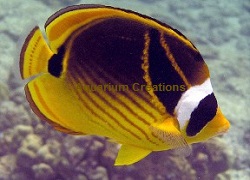
Description:
The peaceful raccoon butterflyfish (Chaetodon lunula) have black and white bands over the face and eyes, similar to a raccoon's mask. Also known as the crescent-masked butterflyfish, lunule butterflyfish, halfmoon butterflyfish, moon butterflyfish, raccoon butterfly, and redstriped butterflyfish. It grows to some 10 inches in length in the wild but only about half that in captivity. In addition to its striking black and white bands over the face and eyes, it has a pattern of reddish stripes on the flanks. They also have a noticeable black blotch at the base of the tail fin - meant to look like an eye to confuse their predators - and oblique yellow stripes behind the head.
Tank Recommendations: The aquarium needs to be at least 125 gallons or larger fish-only aquarium with other butterflyfish. Not good in a reef tank since they will eat invertebrates and corals..
Feeding:
As an Omnivore, they need to be fed both meaty foods and algae foods. Feed frozen and freeze dried crustacean flesh, mysid and Brine shrimp. Feed several times daily. Soak foods in a vitamin supplement such as Selcon for proper nutrition. Feed multiple times per day.
Level of Care: Moderate
Reef Compatibility Not reef safe
Approximate Purchase Size:
Small: 1-1/2" to 2-1/4"; Medium: 2-1/4" to 3-1/2"; Large: 3-1/2" to 4-1/2"; Xlarge 4-1/2" to 6"
Small $84.99
Medium$99.99
Large$149.99
Large$209.99
|
|
Aquarium Conditioned
Red Sea Raccoon Fasciatus Butterflyfish
Chaetodon fasciatus, Red Sea
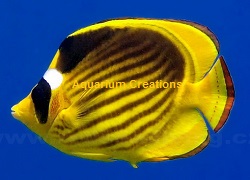
Description:
The Red Sea Raccoon Butterfly is so named for its restricted distribution, found only in the Red Sea and the adjoining Gulf of Aden. Also known as the Raccoon Fasciatus Butterflyfish. Happily for the world of marine aquarists, Red Sea livestock is becoming much more available in terms of numbers to be had. C. fasciatus is a beauty that will eat all types of foods in captivity, including coral polyps. Red Sea Raccoon butterflies are most often seen singly, periodically in pairs, only occasionally in groups. It grows to some 10 inches in the wild but only about half that in captivity.
Tank Recommendations: The aquarium needs to be at least 125 gallons or larger fish-only aquarium with other butterflyfish. Not good in a reef tank since they will eat invertebrates and corals..
Feeding:
As an Omnivore, they need to be fed both meaty foods and algae foods. Feed frozen and freeze dried crustacean flesh, mysid and Brine shrimp. Feed several times daily. Soak foods in a vitamin supplement such as Selcon for proper nutrition. Feed multiple times per day.
Level of Care: Easy
Reef Compatibility Not reef safe
Approximate Purchase Size:
Small: 1-1/2" to 2-1/4"; Medium: 2-1/4" to 3-1/2"; Large: 3-1/2" to 4-1/2"
Small $229.99
Medium$249.99
Large$339.99
|
|
Aquarium Conditioned
Copperband Butterflyfish
Chelmon rostratus, Indonesia
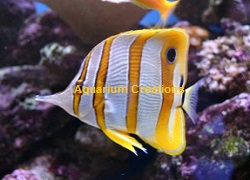
Description:
The Copperband Butterflyfish, Chelmon rostratus, also commonly called the Beak Coralfish, is found in reefs in both the Pacific and Indian Oceans. On the reefs, copperbands live on Aiptasia (indeed many hobbyists introduce this fish for the very purpose of eliminating these pesky anemones), tiny shrimp, fish fry, and worms. From my experience with captive specimens, some will eat Aiptasia, some eat only clams, and some eat only worms. But almost everything they eat is either crawling or sticking out of a rock. That is the purpose of that snout. Copperband butterflyfish can grow to 8 inches but in the home aquarium they max out at about 5 inches. This species can be considered reef safe. It will eat many invertebrates, including parasitic forms such as Calliactis parasitica and common glass anemone (aiptasia). This is not a recommended fish for inexperienced aquarists, as it requires excellent tank conditions to thrive or even survive.
Tank Recommendations: Do not keep with aggressive fish. They are inclined to jump if kept with aggressive fish, as they tend to back up toward the surface while they are pointing their dorsal spines at the aggressor. The aquarium needs to be at least 125 gallons and with plenty of live rock for hiding places, and to supplement feeding.
Feeding:
We feed Copperbands live blackworms and white worms every day. Of course they will also eat other things, but almost never will they eat flakes and pellets, which is something too many people try to give these fish. Besides live worms, you can give them small pieces of clam. We also buy chowder clams and freeze the live clams and then, with a sharp knife, shave off paper-thin slices. Our copperbands will eat this until they can't swallow any more, and because clams are a whole food (guts and all), the copperbands thrive so if you plan on purchasing a Copperband from us please follow our feeding, it works.
Level of Care: Moderate
Reef Compatibility Not Reefsafe
Approximate Purchase Size:
Small: 2 to 2-1/4"; Medium: 2-1/4" to 3-1/2"; Large: 3-1/2" to 4-1/2" XLarge 4-1/2" to 5-1/2"
Small $89.99
Medium$109.99
Large$169.99
XLarge$259.99
|
|
Aquarium Conditioned
Yellow Longnose Butterfly Fish
Forcipiger flavissimus, Indonesia
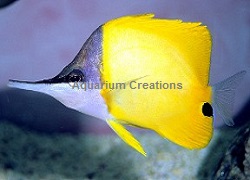
Description:
The Longnose Butterflyfish is a peaceful fish. Kept singly or in larger aquariums as a mated pair, it does better with other non-aggressive fish, but can be placed into a moderately-aggressive community if introduced
into the aquarium first. Smaller non-aggressive fish like cardinalfish, gobies, tilefish, fairy basslets, fairy and flasher wrasses are good candidates as tank mates. Also, larger and rather territorial angelfish can be kept together with this species.
It can be kept with some of the other butterflyfish but will be aggressive towards other members of its own kind, as well as other butterflyfish in its same genus. Small but very territorial fishes like dottybacks should be avoided. Also, fish like basslets or lionfish, even if they are small enough, should be avoided.
Tank Recommendations: If acclimated properly, Longnose Butterflyfish are a hardy addition to any fish-only system. It does best if kept in a 125 gallon or larger tank with peaceful tankmates..
Feeding: As an Omnivore, they need to be fed both meaty foods and algae foods. Feed frozen and freeze dried crustacean flesh, mysid and Brine shrimp. Feed several times daily. Soak foods in a vitamin supplement such as Selcon for proper nutrition. Feed multiple times per day.
Level of Care: Moderate
Reef CompatibilityNot Reef Safe/FONT>
Approximate Purchase Size:
Small: 2" to 3"; Medium:3" to 4"; Large: 4" to 5-1/2"
Small $79.99
Medium$99.99
Large$149.99
|
|
Aquarium Conditioned
Teardrop Butterfly Fish
Chaetodon unimaculatus, Indo Pacific
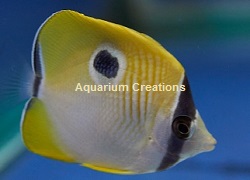
Description:
Teardrop Butterflyfish make an excellent choice for hobbyists looking to add some activity and color to a large FOWLR (fish only with live rock) aquarium. They will be timid and can refuse food during the acclimation process; although they can usually be enticed to eat by feeding live brine shrimp or ghost shrimp. Once they have been eating live food for at least a week, they may also accept frozen and prepared foods. Teardrop's do well with many different tank mates as well as their own species; as long as they aren't housed with species that commonly bully others. Teardrop's require stable, pristine water conditions, open swimming space, sufficient water flow, and hiding places for shelter. A well established aquarium is essential.
Tank Recommendations: House in an established aquarium of at least 100 gallons and provide live rock to form multiple caves and crevices for shelter as well as some open swimming space.
Feeding: In the aquarium they should be provided with a wide variety of meaty foods. Frozen and vitamin-enriched brine shrimp, mysis shrimp, ghost shrimp, chopped krill, chopped crab meat, bloodworms, nori, marine algae, and high quality flake food (preferably Spirulina-based). They will also graze on any filamentous algae thats in the aquarium. Feed twice a day.
Level of Care: Moderate
Reef Compatibility Not Reef Safe
Approximate Purchase Size:
Small: 1-1/2" to 2-1/4"; Medium: 2-1/4" to 3"; Large: 3" to 4-1/2"
Small $89.99
Medium$109.99
Large$169.99
|
|
Aquarium Conditioned
Brown Heniochus Butterflyfish
Chaetodon falcula , Indo Pacific
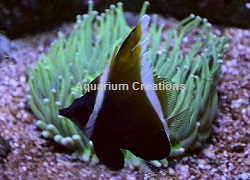
Description:
Brown Heniochus Butterflyfish, Heniochus varius, is often found living on or around the reefs of the Pacific Ocean. Also called the Humphead Bannerfish because it has a large hump above its head (which develops as the fish matures) and an elongated dorsal spine, giving the body a triangular shape. Members of the genus Heniochus, also known as Bannerfish, make gorgeous inhabitants of fish only or aquariums. Soft Corals and most Invertebrates should do fine with the Heniochus, but it may likely decimate Stony Corals, as they are a part of its natural diet. Peaceful or non-aggressive tankmates are recommended to reduce stress on the Butterfly. When Butterflyfish are first introduced to the aquarium, they may refuse to eat. Should the fish continue this behavior for three or more days, live food should be offered (if not from the beginning). Food soaked in a garlic product will often entice the Butterfly to eat. Another useful method to encourage some Butterflyfish to eat is to place their food inside of a coral skeleton.
Tank Recommendations: Brown Heniochus are best maintained in 125 gallon or larger peaceful fish-only aquariums, especially those with lots of open swimming space, with lots of live rock caves to hide in. The Brown Heniochus Butterflyfish may be kept in groupings if there is a large enough aquarium and all are introduced to the aquarium at the same time.
Feeding: Their diet needs to be for a Carnivorous marine fish. Feed frozen and freeze dried crustacean flesh, mysid shrimp and frozen preparations. Feed several times daily. Soak foods in a vitamin supplement such as Selcon for proper nutrition.
Level of Care: Moderate
Reef Compatibility Not Reefsafe
Approximate Purchase Size:
Small: 1-1/2" to 2-1/4"; Medium: 2-1/4" to 3 1/2"; Large: 3 1/2" to 4 1/2"
Small $36.99
Medium$41.99
Large$54.99
|
|
Copyright 2021 Aquarium Creations Online
Photos are representative of each species. All marine life will be unique and variations should be expected, color and sizes may vary.
|






